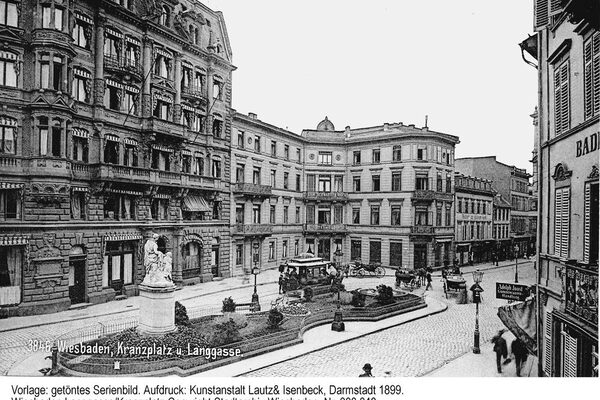Hotel Schwarzer Bock
The Hotel Schwarzer Bock, first mentioned in 1486, was acquired by the Counts of Nassau in 1537, destroyed in the town fire of 1561 and rebuilt in 1578. The most famous room of the Schwarzer Bock, the "Ingelheim Room" with its precious wood paneling, which previously adorned the dining room in Ingelheim Castle, dates from this time. The name "Schwarzer Bock" has appeared since the second half of the 17th century.
In 1717, the inn was owned by Johann Philipp Schramm, valet de chambre to Georg August Samuel Prince of Nassau-Idstein, who had a new building constructed and a horse bath mentioned for the first time in 1728. After his death, the surgeon and hospital administrator Johann Daniel Freinsheim acquired the Hotel Schwarzer Bock, which had 31 rooms in 1818 and, after extensions, 47 beds from 1822.
In 1871/72, the new owner Theodor August Schäfer had the architect Carl von Rößler build a four-storey, two-winged complex in the late classicist style, the front of which was architecturally integrated into the appearance of Kranzplatz. In 1896/97, another new building was constructed according to Carl von Rößler's plans, which was extended after the purchase of the neighboring hotel "Zur Goldenen Kette" and another plot of land in 1905-07 and was given a uniform façade. The owners also acquired the house at Kleine Webergasse 10 together with a spring. A few years later, all the secondary springs on the extended site were combined to form the Drei Lilien Quelle.
During the Second World War, the upper floors of the Schwarzer Bock Hotel were destroyed. In 1945, the US military confiscated the hotel and returned it to the owners in 1957.
At the beginning of the 1960s, the Hotel Schwarzer Bock had a capacity of 235 rooms with 320 beds. Since 1995 - after further renovations and conversions - Radisson SAS (now Radisson Blu) has been the operator of the Hotel Schwarzer Bock.
Literature
Czysz, Walter: Vom Römerbad zur Weltkurstadt, Geschichte der Wiesbadener heißen Quellen und Bäder, Wiesbaden 2000 (Schriften des Stadtarchivs Wiesbaden 7) [p. 321 ff.]
Schaller, Detlef/Schreeb, Hans Dieter: Kaiserzeit. Wiesbaden and its hotels in the Belle Epoque, Wiesbaden 2006 [pp. 46-55].
Spiegel, Margit: Wiesbaden company letterheads. Views of buildings on business letters and invoices. 50 further short portraits of companies and hotels, vol. 2, Wiesbaden 2011 [pp. 123-129].
